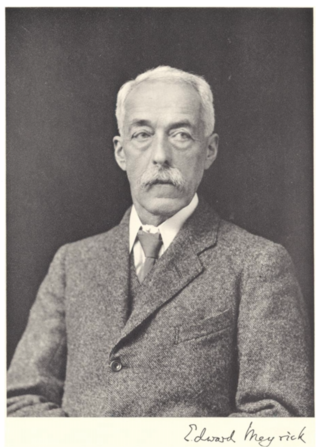
Edward Meyrick was an English schoolmaster and amateur entomologist. He was an expert on microlepidoptera and some consider him one of the founders of modern microlepidoptera systematics.
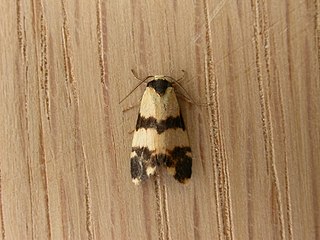
Thallarcha chrysochares is a species of moth of the subfamily Arctiinae first described by Edward Meyrick in 1886. It is found in Australia.
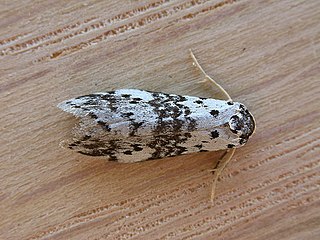
Thallarcha fusa is a species of moth of the subfamily Arctiinae. It was first described by George Hampson in 1900 and it is found in Australia.

Thallarcha albicollis is a moth of the subfamily Arctiinae first described by Rudolf Felder and Alois Friedrich Rogenhofer in 1875. It is found in Australia, including Tasmania.
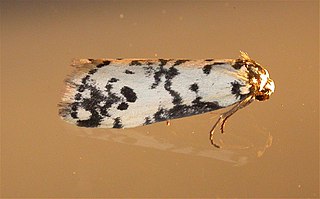
Thallarcha eremicola is a moth of the subfamily Arctiinae first described by Richard Thomas Martin Pescott in 1951. It is found in Australia.

Thallarcha partita is a moth of the subfamily Arctiinae first described by Francis Walker in 1869. It is found in the Australian states of New South Wales, Queensland and Victoria.

Thallarcha sparsana, the fair footman, is a moth of the subfamily Arctiinae. The species was first described by Francis Walker in 1863. It is found in the Australian states of Victoria, New South Wales and Queensland.
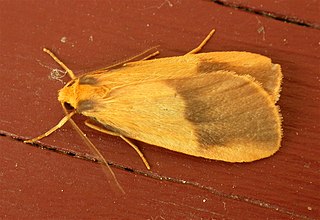
Threnosia heminephes, the halved footman, is a moth of the subfamily Arctiinae first described by Edward Meyrick in 1886. It is found in Australia, where it has been recorded from the Australian Capital Territory, New South Wales and Victoria.

Thallarcha is a genus of moths in the subfamily Arctiinae.

Macrobathra is a genus of moths in the family Cosmopterigidae. Most species are endemic to Australia.
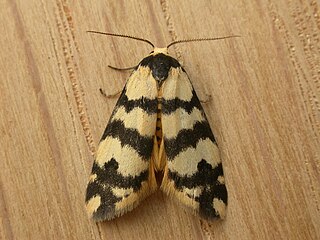
Thallarcha trissomochla is a moth of the subfamily Arctiinae first described by Alfred Jefferis Turner in 1940. It is found from Townsville in Queensland to northern New South Wales.
Thallarcha jocularis is a moth of the subfamily Arctiinae first described by Rudolph Rosenstock in 1885. It is found in the Australian states of New South Wales and Victoria.

The Autostichinae are a subfamily of moths in the superfamily Gelechioidea. Like their relatives therein, their exact relationships are not yet very well resolved. The present lineage was often included in the concealer moth family (Oecophoridae), but alternatively it is united with the Symmocidae sensu stricto to form an expanded family Autostichidae.
Thallarcha isophragma is a moth in the subfamily Arctiinae. It was described by Edward Meyrick in 1886. It is found in Australia, where it has been recorded from Tasmania.
Thallarcha lechrioleuca is a moth in the subfamily Arctiinae. It was described by Alfred Jefferis Turner in 1940. It is found in Australia, where it has been recorded from South Australia, Victoria and Western Australia.
Thallarcha lochaga is a moth in the subfamily Arctiinae. It was described by Edward Meyrick in 1886. It is found in Australia, where it has been recorded from New South Wales and Queensland.
Thallarcha macilenta is a moth in the subfamily Arctiinae. It was described by Thomas Pennington Lucas in 1894. It is found in Australia, where it has been recorded from New South Wales and Queensland.
Thallarcha phalarota, the adorned footman, is a moth in the subfamily Arctiinae. It was described by Edward Meyrick in 1886. It is found in Australia, where it has been recorded from the Australian Capital Territory, New South Wales, Queensland and Victoria.
Thallarcha staurocola is a moth in the subfamily Arctiinae. It was described by Edward Meyrick in 1886. It is found in Australia, where it has been recorded from New South Wales, Queensland and Victoria.










